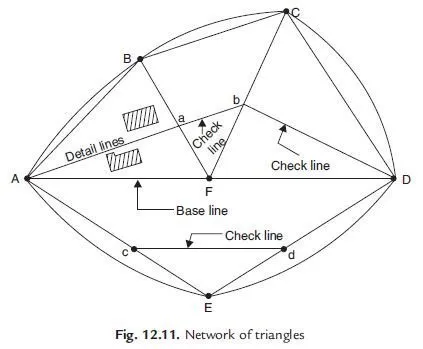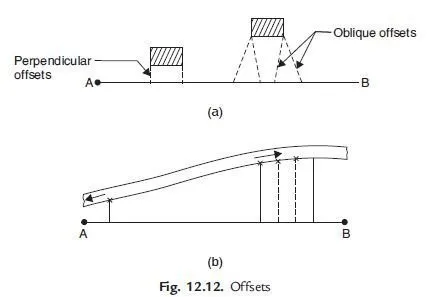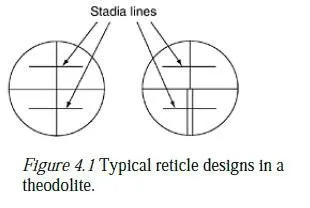Chain survey is suitable in the following cases:
(i) Area to be surveyed is comparatively small
(ii) Ground is fairly level
(iii) Area is open and
(iv) Details to be filled up are simple and less.
In chain surveying only linear measurements are made i.e. no angular measurements are made.
Since triangle is the only figure that can be plotted with measurement of sides only, in chain surveying the area to be surveyed should be covered with a network of triangles. Figure 12.11 shows a typical scheme of covering an area with a network of triangles. No angle of the network triangles should be less than 30º to precisely get plotted position of a station with respect to already plotted positions of other station. As far as possible angles should be close to 60º. However, the arrangements of triangles to be adopted depends on the shape, topography, natural and artificial obstacles in the field.
Technical Terms
Various technical terms used in connection with the network of the triangles in surveying are explained below:
Station: Station is a point of importance at the beginning or at the end of a survey line.
Main station: These are the stations at the beginning or at the end of lines forming main skeleton. They are denoted as A, B, C etc. Subsidiary or tie stations: These are the stations selected on main lines to run auxiliary/secondary lines for the purpose of locating interior details. These stations are denoted as a, b, c, …., etc., or as 1, 2, 3, … etc. Base line: It is the most important line and is the longest. Usually it is the line plotted first and then frame work of triangles are built on it.
Detail lines: If the important objects are far away from the main lines, the offsets are too long, resulting into inaccuracies and taking more time for the measurements. In such cases the secondary lines are run by selecting secondary stations on main lines. Such lines are called detail lines.
Check lines: These are the lines connecting main station and a substation on opposite side or the lines connecting to substations on the sides of main lines. The purpose of measuring such lines is to check the accuracy with which main stations are located.
Selection of Stations
The following points should be considered in selecting station points:
(i) It should be visible from at least two or more stations.
(ii) As far as possible main lines should run on level ground.
(iii) All triangles should be well conditioned (No angle less than 30º).
(iv) Main network should have as few lines as possible.
(v) Each main triangle should have at least one check line.
(vi) Obstacles to ranging and chaining should be avoided.
(vii) Sides of the larger triangles should pass as close to boundary lines as possible.
(viii) Tresspassing and frequent crossing of the roads should be avoided.
Offsets
Lateral measurements to chain lines for locating ground features are known as offsets. For this purpose perpendicular or oblique offsets may be taken (Ref. Fig. 12.12). If the object to be located (say road) is curved more number of offsets should be taken. For measuring offsets tapes are commonly used.
For setting perpendicular offsets any one of the following methods are used:
(i) Swinging
(ii) Using cross staffs
(iii) Using optical or prism square.
Perpendicular Offset by Swinging
Chain is stretched along the survey line. An assistant holds the end of tape on the object. Surveyor swings the tape on chain line and selects the point on chain where offset distance is the least (Fig. 12.13) and notes chain reading as well as offset reading in a field book on a neat sketch of the object.
Perpendicular Offsets Using Cross Staffs
Figure 12.14 shows three different types of cross staffs used for setting perpendicular offsets. All cross staffs are having two perpendicular lines of sights. The cross staffs are mounted on stand. First line of sight is set along the chain line and without disturbing setting right angle line of sight is checked to locate the object. With open cross staff (Fig. 12.14 (a)) it is possible to set perpendicular only, while with french cross staff (Fig. 12.14 (b)), even 45º angle can be set. Adjustable cross staff can be used to
set any angle also, since there are graduations and upper drum can be rotated over lower drum.
Perpendicular Offsets Using Optical Square and Prism Square
These instruments are based on the optical principle that if two mirrors are at angle θ to each other, they reflect a ray at angle 2θ. Figure 12.15 shows a typical optical square.
Optical square consists of a metal box about 50 mm in diameter and 125 mm deep. In the rim of
the box there are three openings:
(i) a pin hole at E
(ii) a small rectangular slot at G, and
(iii) a large rectangular slot at F.
A and B are the two mirrors placed at 45º to each other. Hence the image of an object at F which falls on A gets reflected and emerge at E which is at right angles to the line FA. The mirror A which is opposite to the opening at F is fully silvered. It is fitted to a frame which is attached to the bottom plate. If necessary this mirror can be adjusted by inserting a key on the top of the cover. The mirror B which is in the line with EG is silvered in the top half and plain in the bottom half. It is firmly attached to the bottom plate of the box.
The ranging rod at Q is directly sighted by eye at E in the bottom half of the B which is a plain glass. At the same time in the top half of B, the reflected ray of the object at P is sighted. When the image of P is in the same vertical line as the object at Q, then the lines PA is at right angles to the line EB. This instrument can be used for finding foot of the perpendicular or to set a right angle.
In prism square, instead of two mirrors at 45º to each other a prism which has two faces at 45º to each other is used [Fig. 12.16.]. Its advantage is it will not go out of adjustment even after long usage.
Field Book
All observations and measurements taken during chain surveying are to be recorded in a standard field book. It is a oblong book of size 200 mm × 120 mm, which can be carried in the pocket.
There are two forms of the book (i) single line and (ii) double line. The pages of a single book are having a red line along the length of the paper in the middle of the width. It indicates the chain line.
All chainages are written across it. The space on either side of the line is used for sketching the object and for noting offset distances. In double line book there are two blue lines with a space of 15 to 20 mm is the middle of each book. The space between the two lines is utilised for noting the chainages. Figure 12.17 shows typical pages of a field books.
Field Work
As soon as the survey party arrives in the field the following details are entered in the field book:
(i) Title of the survey work
(ii) The date of survey
(iii) The names of the members of the party.
The field work may be divided into the following:
(i) Reconnaissance survey.
(ii) Marking stations, drawing reference sketches.
(iii) Line by line surveying.
Reconnaissance survey consists in going round the field and identifying suitable stations for the network of triangles. Neat sketch of network is drawn and designated. The typical key plan drawn is similar to one shown in Fig. 12.11.
All main stations should be marked on the ground. Some of the methods used for marking are:
(a) Fixing ranging poles
(b) Driving pegs
(c) Marking a cross if ground is hard
(d) Digging and fixing a stone.
Then reference sketches are drawn in the field book so as to identify stations when the development works are taken up. For this measurements with respect to three permanent points are noted. The permanent points may be
(a) Corner of a building
(b) Posts of gates
(c) Corners of compound walls
(d) Electric poles
(e) A tree.
After that, line by line surveying is conducted to locate various objects with respect to chain lines.
Office Work
It consists in preparing the plan of the area to a suitable scale making use of measurements and sketches
noted in the field book.











thank you for the notes …. they are very helpful for me…………
express most useful my exms this notes..
Thanks
its very good ………….bt a bit more info would make far more better
there is no need to go to the colleges for lectures i find everything here about surveying
Thank you for this helpful notes
thank you for the notes ……………………….,express most useful my exams this notes thank so much
Thank you
It’s very important for all enng. student……so thank’s very much.
thanks
THANKS
Brilliant…… very helpful from exam perspective!!
i have a not surveying books so very helfful from your notes
THANK FOR THIS NOTS
Thanx a lot for providing us such a brilliant stuff. It is very useful.
thanku
very usefull.
very understandable notess…thanks
thats good and thanku for the notes….
thanks for your valuble information
The notes seems to be helpful,thanks!!